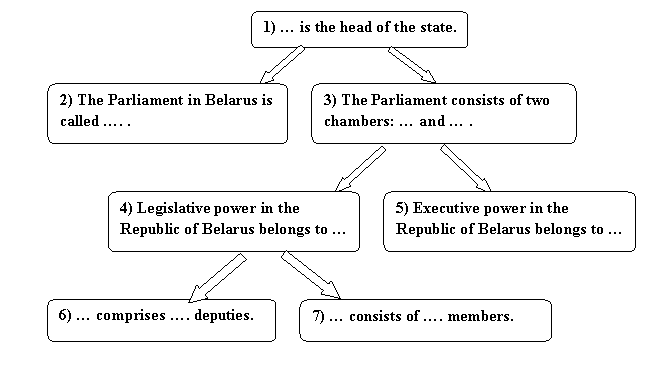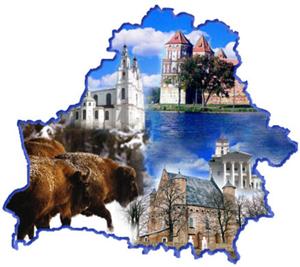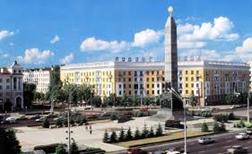VII. Answer the following questions.
1. Where is the Republic of Belarus situated?
2. What area does it cover?
3. What countries does it border on?
4. What is the population of Belarus?
5. What nationalities does the population include?
6. What is the main religion in the country?
7. How many official languages does the country have?
8. How many regions is the Republic of Belarus divided territorially into?
9. How many administrative districts does the country include?
10. What is the largest city in the country?
11. The climate in Belarus is moderate continental, isn’t it?
12. What is the average January (July) temperature?
13. Do forests occupy about 40 per cent of the country’s area?
14. How many rivers and lakes does Belarus have?
15. What are the longest rivers in the country?
16. What are the largest lakes in Belarus?
17. How many types of mineral resources have been found in Belarus?
18. What mineral is of special significance?
19. What non-ore minerals is the Republic rich in?
20. Are peat reserves widely spread in Belarus?
21. What are Belarus's main agricultural products?
22. What does Belarusian industry produce?
23. What are the main industries for local consumption?
24. Is Belarus governed by the President and the National Assembly?
25. What is the National Assembly?
26. How many chambers does the Parliament consist of?
27. What state body does the executive power in the Republic of Belarus belong to?
28. Who heads the Council of Ministers?
VIII. Agree or disagree with the statements using the following phrases: Yes, I agree that... / It is true that... / Yes, I think that … Or: I don't think that is correct ... / I can't agree with the fact that... / No, I don't think you are right...
1) Belarus is situated in the western part of Europe. 2) It borders on Germany and France. 3) Our native land is very beautiful. 4) Most of the Belarusian territory is covered with mountains. 5) The climate in Belarus is moderate continental. 6) The main religion in the country is Roman Catholicism. 7) Urban population makes up 70% of people. 8) The Nieman is the longest river in Belarus. 9) The country is famous for its national reservations. 10) Natural conditions of the Republic of Belarus are favorable for production of milk, beef, pork, grain, potatoes, flax, white beet and so on. 11) The economic potential of Belarus is largely dependent on agriculture. 12) The judicial power in the republic belongs to the courts.
IX. Using the following plan speak about the state system of the Republic of Belarus.

X. Role play the dialogue. Two students meet at the international students’ conference.
Student 1: My congratulations. Your presentation was a real success.
Student 2: Thank you. I’m very glad it was received so well.
Student 1: Your name is Katya, isn’t it?
Student 2: Yes.
Student 2: And I’m Peter.
Student 1: It’s nice to meet you Peter.
Student 2: You too. Where are you from?
Student 2: I’m from Belarus.
Student 1: Where is it?
Student 2: In Eastern Europe.
Student 1: What city are you from?
Student 2: Grodno. It is located on the Neman River, close to the borders of Poland and Lithuania.
Student 1: I’m sorry, but I don’t really know Belarus very well. What is the capital of your country?
Student 2: Minsk city is the capital and largest city of Belarus.
Student 1: I think I’ve heard of it. It’s where the World Ice Hockey Championship was held in May 2014.
Student 2: Exactly. Minsk is famous for its sports centers. The largest of them is Minsk Arena where many hockey matches were played.
Student 1: Well, it’s been nice talking to you. It is getting rather late and I should be leaving.
Student 2: Maybe we’ll meet tomorrow.
Student 1: I hope so. Good-bye.
Student 2: Good-bye.
XI. Speak about the Republic of Belarus using the following plan.
1.  Geographical position.
Geographical position.
2. Population, religions and languages.
3. Administrative division.
4. Capital.
5. Climate and landscape.
6. Natural resources.
7. Economy of Belarus.
8. State system.
Self check |
XII. Translate into English using words from Active and Reference Vocabulary.
1. Республика Беларусь расположена в Восточной Европе и граничит со многими странами: на востоке с Россией, на юге с Украиной, на западе с Польшей, на северо-западе с Литвой и Латвией.
2. По своей площади наша Республика занимает 13-е место среди стран Европы и 6-е среди стран Содружества.
3. На территории Беларуси проживает около 10 млн. человек.
4. Столица нашего государства – Минск.
5. Сегодня Минск – современный европейский город, самый крупный в стране.
6. Государственными языками в республике являются белорусский и русский.
7. Согласно административному делению наша Республика состоит из 6 областей: Минской, Гродненской, Брестской, Витебской, Гомельской и Могилевской.
8. Климат Беларуси – умеренно-континентальный.
9. Примерно 1/3 территории Республики покрыта лесами.
10.Самая длинная река Беларуси – Днепр.
11.Реки Беларуси относятся к бассейнам двух морей – Балтийского и Черного.
12. Самое большое озеро в республике – озеро Нарочь в Минской области, а самое глубокое – озеро Долгое в Витебской области.
13. Наша Республика богата различными полезными ископаемыми.
14. В Беларуси имеется около 30 видов минерального сырья.
15. Беларусь богата залежами калийных солей и торфа.
16. Основными отраслями народного хозяйства являются машиностроение, электротехническая промышленность, легкая, химическая и пищевая промышленности и другие.
17. Особое значение имеет производство искусственного волокна, минеральных удобрений, строительных материалов и большегрузных самосвалов.
18. Сельское хозяйство специализируется на продукции животноводства (молоко, мясо), а также на выращивании зерновых, картофеля, овощей, сахарной свеклы, льна.
19. Во главе нашего государства стоит президент.
20. С 1994 года президентом РБ является .
21. Наш парламент (Народное собрание) состоит из двух палат: Палаты представителей и Совета Республики.
22. Депутаты парламента избираются всеми гражданами Республики.
23. Палата представителей состоит из 110 депутатов, а Совет Республики из 64.
24. Совет Министров РБ является центральным органом государственного управления.

PART II
Text 2 |
I. Read and memorize the following word combinations. Translate the sentences.
1. castle – замок
The country also has several medieval castles and baroque churches that are real treat for the eyes.
2. fortress – крепость
The Brest Fortress is a monument of architecture of the 19th century.
3. to house – включать, содержать
The library houses the third largest collection of books after the Russian State Library and the National Library in St. Petersburg.
4. invasion – вторжение, нашествие
The castle has been protecting the old city from the invasion of Tartars and several enemy attacks over the centuries.
5. palace and park ensemble – дворцово-парковый ансамбль
The Palace of Rumyantsevs-Paskeviches is the main historical and cultural site of Gomel Palace and Park Ensemble.
6. sightseeing – осмотр достопримечательностей
Sightseeing tour of Minsk includes the main avenues (Independence Avenue, Victory Avenue) and the architectural monuments of the 17th - 20th centuries.
7. State List of the Historical Cultural Values – Государственный список историко-культурных ценностей
The state list of the historical-cultural values of Belarus includes 4413 objects of architecture, history, archeology and others.
8. tourist destination/attraction – туристическая дестинация /достопримечательность
The Victory square is located in the center of the City of Minsk and is both key tourist attraction and place of pilgrimage for Belarusians.

II. Read and translate the text.
Sightseeing in Belarus
 You can start your Sightseeing in Belarus right from the capital city Minsk. It is a beautiful city, which has been restored after the World War II. It is one of the most frequented Tourist Destinations in Belarus. A cultural tour of Minsk will take you to various museums of the city, the Botanical Garden, the National Library of Belarus.
You can start your Sightseeing in Belarus right from the capital city Minsk. It is a beautiful city, which has been restored after the World War II. It is one of the most frequented Tourist Destinations in Belarus. A cultural tour of Minsk will take you to various museums of the city, the Botanical Garden, the National Library of Belarus.
National Library of Belarus
 Being the main cultural and information center of the country, the National Library of Belarus is visited by more than 2,200 people daily. The library houses the third largest collection of books after the Russian State Library and the National Library in St. Petersburg. It is located in a modern 72-metre high building, has 22 floors and provides more than 2,000 seats for the readers including 500-seat conference hall. It now functions successfully both as library and city attraction. The country also has several medieval castles and baroque churches that are real treat for the eyes.
Being the main cultural and information center of the country, the National Library of Belarus is visited by more than 2,200 people daily. The library houses the third largest collection of books after the Russian State Library and the National Library in St. Petersburg. It is located in a modern 72-metre high building, has 22 floors and provides more than 2,000 seats for the readers including 500-seat conference hall. It now functions successfully both as library and city attraction. The country also has several medieval castles and baroque churches that are real treat for the eyes.

|
Из за большого объема этот материал размещен на нескольких страницах:
1 2 3 4 5 6 7 8 9 10 11 12 13 14 15 16 17 18 |





